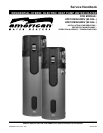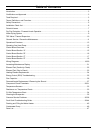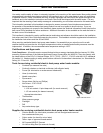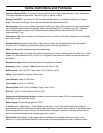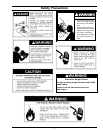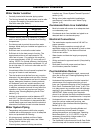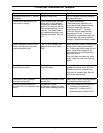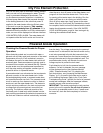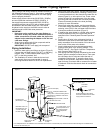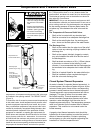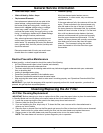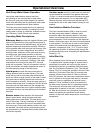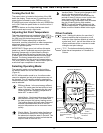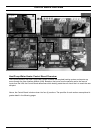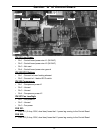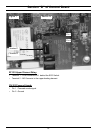
8
Dry Fire is a term used to describe a heating element
that is on and not fully submerged in water. This will
result in permanent damage to the element. The
dry fi re element protection algorithm is installed on
this heat pump water heater and prevents damage
to the heating elements in the event that power is
applied to the water heater without suffi cient water
in the tank to cover the elements. This routine
takes approximately four (4) minutes. If it is
determined that the element is not fully submersed in
water, an error will be displayed on the user interface:
LOW WATER LEVEL ALARM. The water heater will
not operate while this fault is active and it must be
cleared before the water heater will operate. In order to
clear the error, shut off power to the water heater, and
purge all air from the water heater tank. This is done
by opening all hot water taps in the building. Run the
water until there is no air coming out with the water.
Shut off all hot water taps. Apply power to the water
heater. After four (4) minutes, dry fi re detection should
be complete, the error should be cleared and the water
heater should operate normally. If the LOW WATER
LEVEL ALARM repeats, purge air from tank again by
following the method outlined above.
Dry Fire Element Protection
Checking the Powered Anode for Proper
Operation:
When dissimilar metals are in contact with water, a
galvanic cell will likely result and corrosion of the metal
components will occur. If left unchecked, corrosion
will weaken the wall of a water heater tank which will
eventually leak. Passive anodes are typically used to
counteract this corrosion and extend tank life. Passive
anodes erode over time and become less effective
until they stop working all together, another type of
protective device is a powered anode.
A powered anode is an active device that counteracts
galvanic corrosion in the water heater tank. Unlike
a standard depleting anode, a powered anode does
not lose effectiveness over time. The powered anode
circuit is made up of an electronic control, a titanium
anode rod, and the water heater tank. The electronic
control monitors conditions in the tank and produces
a voltage that will prevent galvanic corrosion from
occurring. The titanium anode rod consists of two
functional parts: A steel body which threads into the
tank providing mechanical and electrical connection to
the tank and a titanium rod that is electrically insulated
from the body. The voltage produced by the powered
anode circuit is delivered to the titanium anode rod by
a red wire connected to the tab that connects to the
anode rod. Current fl ows from the titanium anode rod,
through the water and to the grounded tank wall. The
powered anode circuitry will maintain the minimum
voltage required to protect the tank steel.
Fault detection is built into the powered anode
software. If a fault is detected, an error message
will be displayed on the User Interface Module
(UIM): “Powered Anode Fault”. By checking the
fault code history, see “Accessing the Maintenance
Display” (p.21), a specifi c fault code can be read to
aid in isolating the cause. Refer to the “Fault Code
Troubleshooting Guide” (p39-44) for the list of powered
anode fault messages, what the messages indicate,
possible causes, and corrective actions.
IMPORTANT: The anode protecting the tank requires
power to the unit to operate. Do not shut off power to
the unit for an extended period of time. If power must
be turned off, drain the tank completely to minimize
corrosion.
Powered Anode Operation



